Yucca Gardena, who arrived in a temperate climate from the subtropics and tropics of Central America, will help in the original landscaping of personal gardens. An exotic plant, reminiscent of a kind of palm tree, is gaining more and more popularity among landscape designers every day.
Material Content:
Description of species and varieties

Despite the fact that the genus has 30 species in its natural habitat, which can be stemless and tree-like, in moderate latitudes the garden yucca (filamentoza) is represented by two varieties:
- Filamentous yucca is a stemless species represented by plants with deep rhizomes that allow the culture to withstand frosts down to -20 ° C. Narrow leaves up to 700 cm long are collected in magnificent rosettes. The variety owes its name to swirling white threads descending from the edges of leaf plates painted in a bluish tint. Variegated forms of a typical variety with white spots and yellow-green color were developed.
- Yucca Sizaya is a tree-like evergreen species up to 1 m high with a short trunk, the top of which is decorated with a bunch of dense spear-shaped leaf plates of gray-green color. During flowering, a large apical inflorescence of white flowers forms.
Nuances of growing a plant

When cultivating a yucca garden should take into account the characteristics of the culture:
- the need for good lighting;
- Intolerance of moisture stagnation;
- love of moderate watering;
- the need for additional nutrition;
- need for periodic transplants;
- winter tolerance of the plant.
Planting yucca garden in the open ground
So that subsequent care does not take much time and effort, it is necessary to correctly plant a yucca in the garden.
Seat selection

When looking for a place for yucca in the garden, you should give preference to sunny, sheltered from the wind, avoiding shaded areas, when placed on which the culture loses decorative qualities due to the extension of the stem and the foliage that has lost turgor. An exotic plant is undemanding to the composition of soils, but it develops much better on fertile lands.
Mandatory requirements for the selection of soil are:
- drainage;
- friability;
- ease.
Timing and landing technology
It is recommended to plant seedlings in open ground after establishing a stable temperature at night at around 10 ° C. A landing pit is made on the site with a width of 70 cm and a depth of up to half a meter. A drainage layer of gravel is placed at the bottom. Next, wood ash and humus are poured into the pit. When the yucca roots are in the pit, the plant is dug in. The trunk circle is compacted and well watered.
Advice! In order not to injure your hands with dense leaves, protect them with garden gloves.
Care and proper transplantation
If the landing was made in the appropriate area with fertile and loose soil, then caring for the yucca will be only a joy.
Watering and spraying
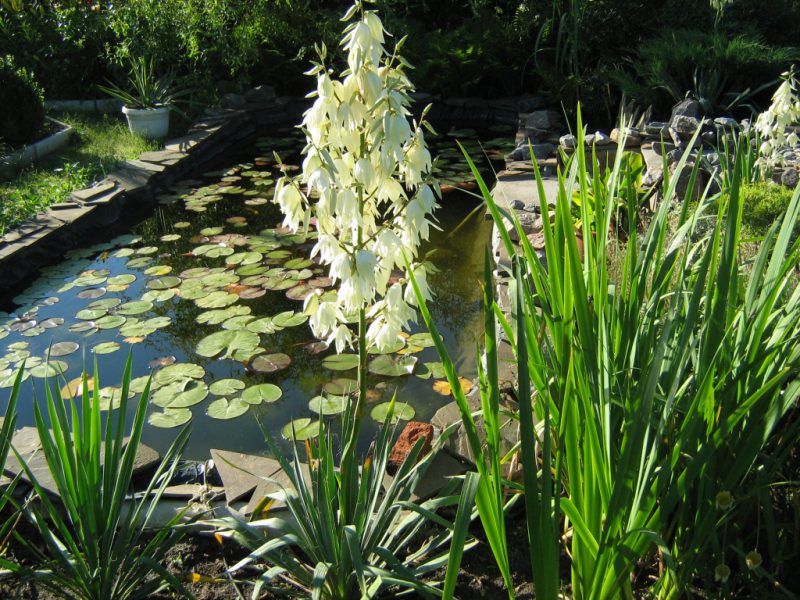
A drought-tolerant plant is more afraid of excess moisture, so it does not need frequent and plentiful watering. During heat periods, the yucca should be watered after the upper soil layer has completely dried. With prolonged air drought, when the leaves begin to lose elasticity, sprinkling of the culture should be carried out. The best time is morning or evening.
Fertilizing and fertilizers
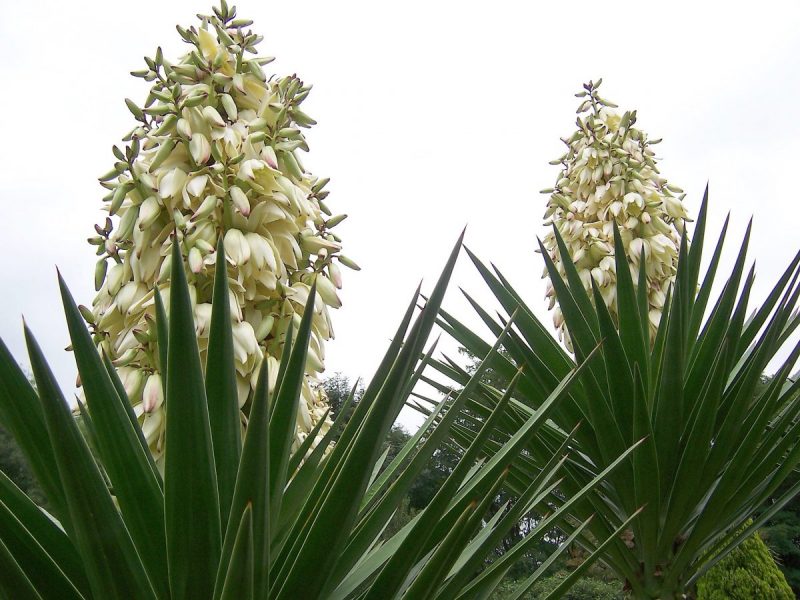
To maintain the decorativeness of the plant and the necessary level of soil fertility, it is necessary to feed the yucca with complex mineral fertilizers twice during the growing season:
- In May, the inhabitants of the tropics are fed ammophos with a high concentration of nitrogen.
- After flowering, nitrogen can be virtually eliminated from top dressing.
Important! For additional nutrition, you can use special complexes for succulents.
Yucca Garden Transplant
A garden yucca, which has been growing in one place for a long time, definitely needs a transplant.
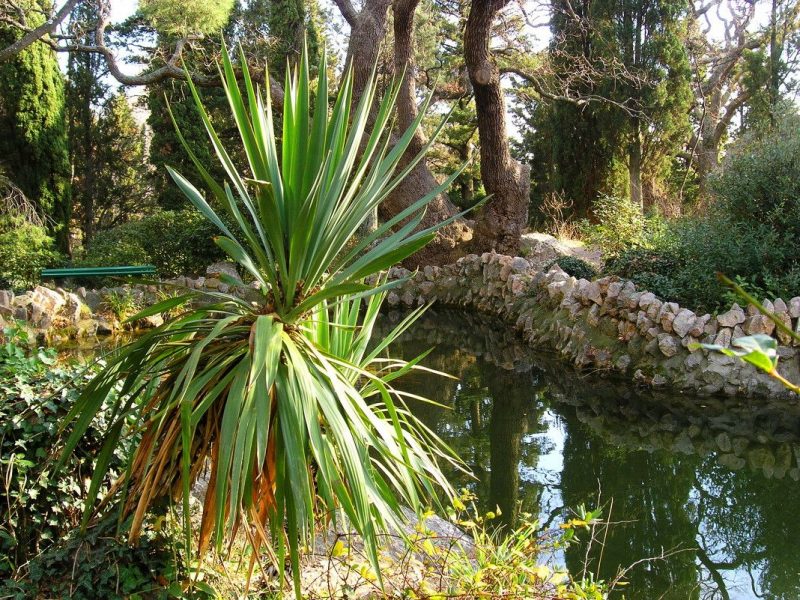
The procedure is not carried out too often as follows:
- In the spring or at the end of the summer period, the plant is carefully removed from the ground so as not to injure long roots.
- The flower is planted in a prepared hole in a new area with a similar relief.
- Within 2 weeks, the planting field, the culture is fed with liquid mineral complexes with a reduced concentration of 2 times.
Treatment for diseases and pests
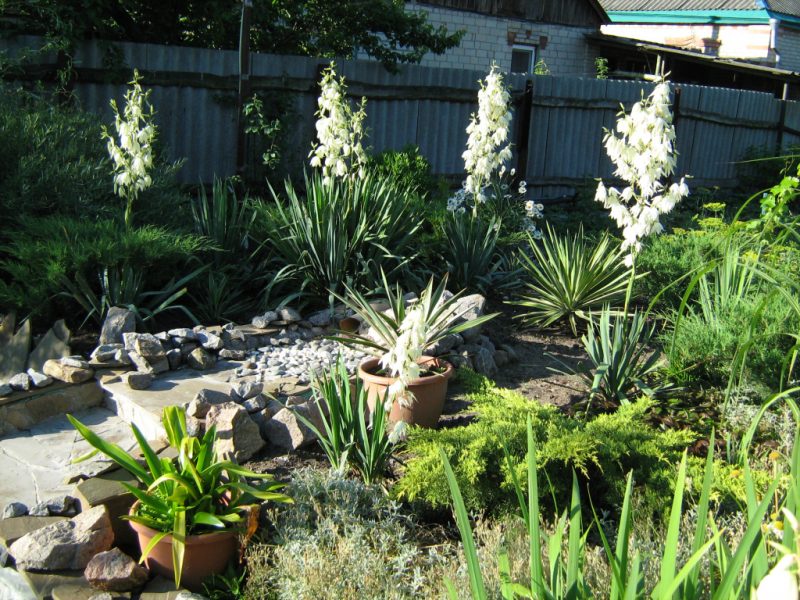
Among the diseases on the Yucca Garden, gray rot may develop, which develops due to violation of the irrigation regime. To cure the plant, it is recommended to treat it with fungicide. From pests such as aphids and spider mites, which damage the decorative leaves of the culture, insecticides will help.
How to hide and save filamentoza in winter
Since the varieties of yucca garden are quite winter-hardy, then digging them out of the open ground is not necessary. But in areas with a harsh climate, it is recommended to insulate the exotic inhabitants of the garden. Young specimens up to the age of three are insulated in any area where there is a threat of snowy winters and severe frosts, even short-term ones.
When sheltering in the second half of autumn, you can use one of the ways to shelter filamentoza:
- When precipitation is not expected, it is worth tying the ground part of the evergreen plant in a tight bunch, leaving several lower leaf plates to protect the soil from freezing. Sprinkle the trunk circle with fallen garden foliage and cover with boards, which will not allow the wind to blow off the leaves. Wrap the bound part of the yucca with plastic wrap and sprinkle the trunk with soil.
- As a protective structure, you can use a wooden box that is installed above the plant and covered with polystyrene and roofing felt. From above, the shelter is sprinkled with fallen leaves, which is fixed with the help of fir spruce branches. In the final, the entire defensive structure is wrapped in film.
Attention! It is recommended to remove the protective cover after the threat of freezing frost has completely passed.
How to propagate a plant
An exotic plant can be propagated in several ways.
Bush division

Due to the simplicity of execution, the reception is very popular. The procedure is carried out during a transplant, when the rhizome is divided into parts that are seated in places slightly shaded from the sun and fed after rooting.
Cuttings
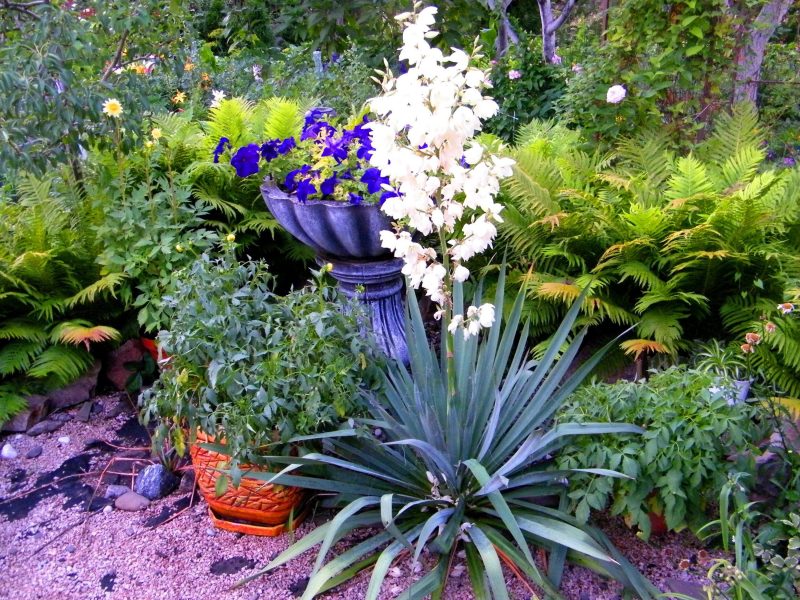
With this method of propagation, a stem with a bunch of leaf plates is prepared from the apical part of the stem. Planting material is dried in the air for several days and buried in perlite, where it is rooted during systematic spraying.
Seed way
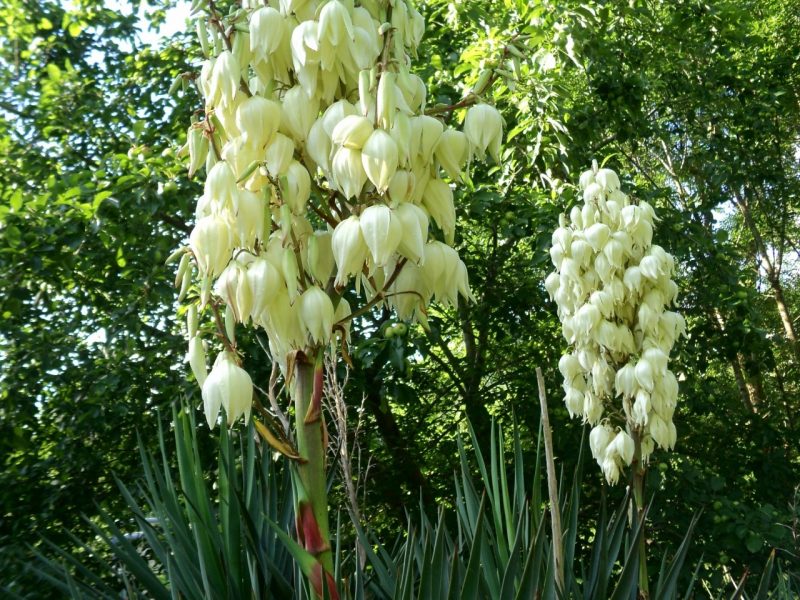
Garden yucca can be planted with seeds purchased at a flower shop or harvested independently, according to the following scheme:
- A fertile substrate is prepared from sheet, soddy ground and sand in equal parts.
- Seeds are distributed over previously disinfected soil, after which the container is covered with a film.
- After emergence, the material that creates the greenhouse conditions is removed.
- When the seedlings develop 2 pairs of real leaves, they dive in separate pots.
- Strong open seedlings are planted in open ground.
Thus, if the gardener had a desire to create an exotic corner with representatives of the tropical flora on the plot, then planting a yucca garden would be an excellent solution.












